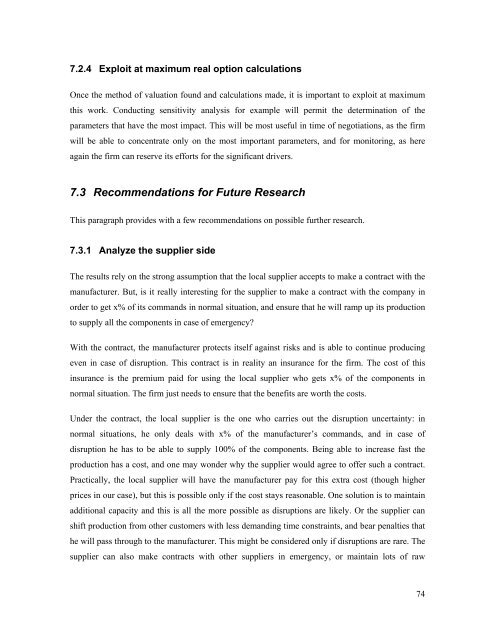Managing Risks of Supply-Chain Disruptions: Dual ... - CiteSeerX
Managing Risks of Supply-Chain Disruptions: Dual ... - CiteSeerX
Managing Risks of Supply-Chain Disruptions: Dual ... - CiteSeerX
Create successful ePaper yourself
Turn your PDF publications into a flip-book with our unique Google optimized e-Paper software.
7.2.4 Exploit at maximum real option calculationsOnce the method <strong>of</strong> valuation found and calculations made, it is important to exploit at maximumthis work. Conducting sensitivity analysis for example will permit the determination <strong>of</strong> theparameters that have the most impact. This will be most useful in time <strong>of</strong> negotiations, as the firmwill be able to concentrate only on the most important parameters, and for monitoring, as hereagain the firm can reserve its efforts for the significant drivers.7.3 Recommendations for Future ResearchThis paragraph provides with a few recommendations on possible further research.7.3.1 Analyze the supplier sideThe results rely on the strong assumption that the local supplier accepts to make a contract with themanufacturer. But, is it really interesting for the supplier to make a contract with the company inorder to get x% <strong>of</strong> its commands in normal situation, and ensure that he will ramp up its productionto supply all the components in case <strong>of</strong> emergency?With the contract, the manufacturer protects itself against risks and is able to continue producingeven in case <strong>of</strong> disruption. This contract is in reality an insurance for the firm. The cost <strong>of</strong> thisinsurance is the premium paid for using the local supplier who gets x% <strong>of</strong> the components innormal situation. The firm just needs to ensure that the benefits are worth the costs.Under the contract, the local supplier is the one who carries out the disruption uncertainty: innormal situations, he only deals with x% <strong>of</strong> the manufacturer’s commands, and in case <strong>of</strong>disruption he has to be able to supply 100% <strong>of</strong> the components. Being able to increase fast theproduction has a cost, and one may wonder why the supplier would agree to <strong>of</strong>fer such a contract.Practically, the local supplier will have the manufacturer pay for this extra cost (though higherprices in our case), but this is possible only if the cost stays reasonable. One solution is to maintainadditional capacity and this is all the more possible as disruptions are likely. Or the supplier canshift production from other customers with less demanding time constraints, and bear penalties thathe will pass through to the manufacturer. This might be considered only if disruptions are rare. Thesupplier can also make contracts with other suppliers in emergency, or maintain lots <strong>of</strong> raw74
















